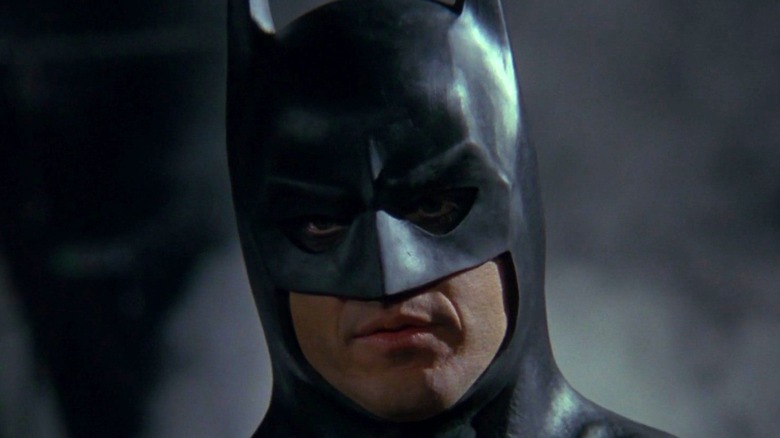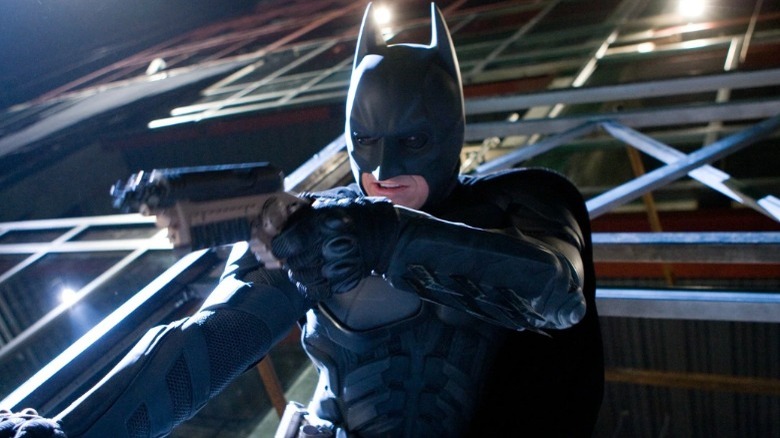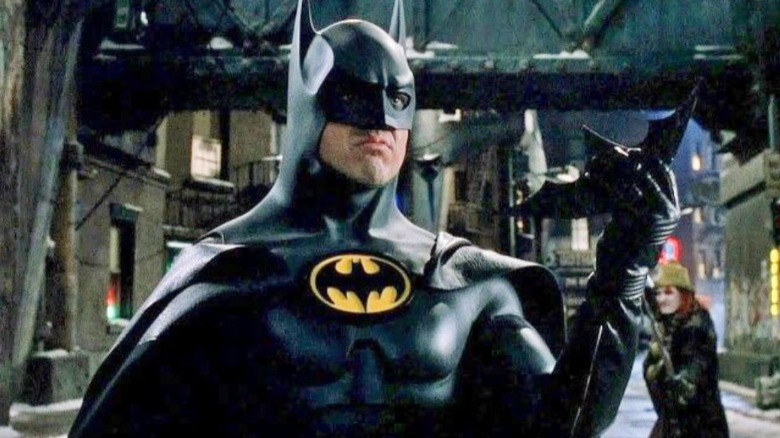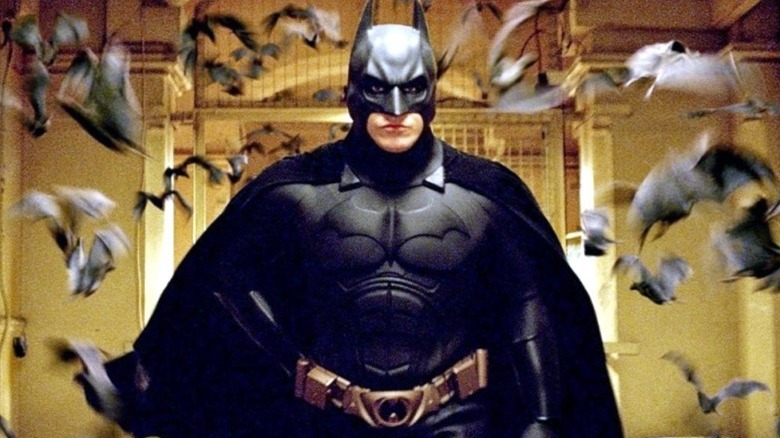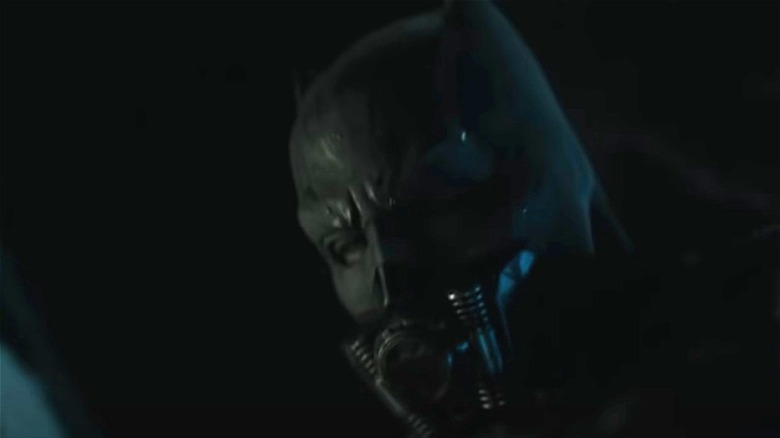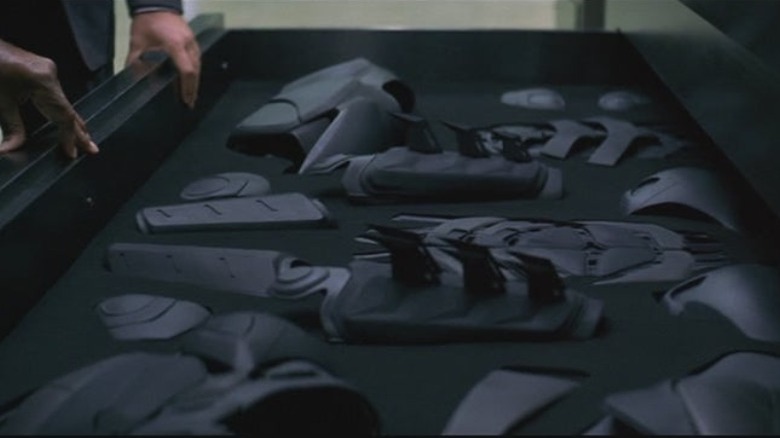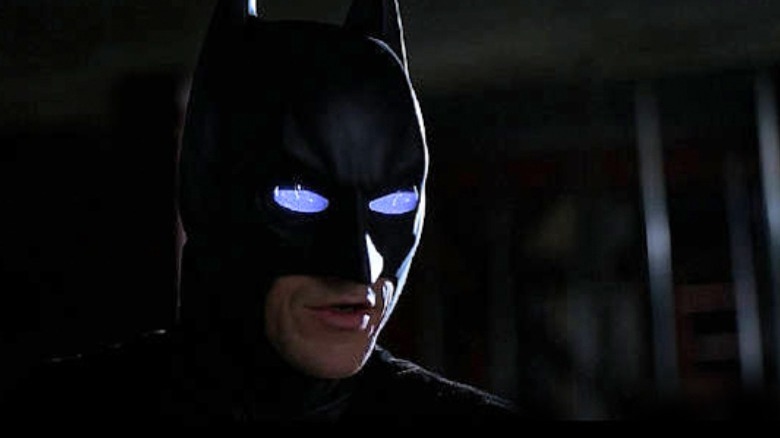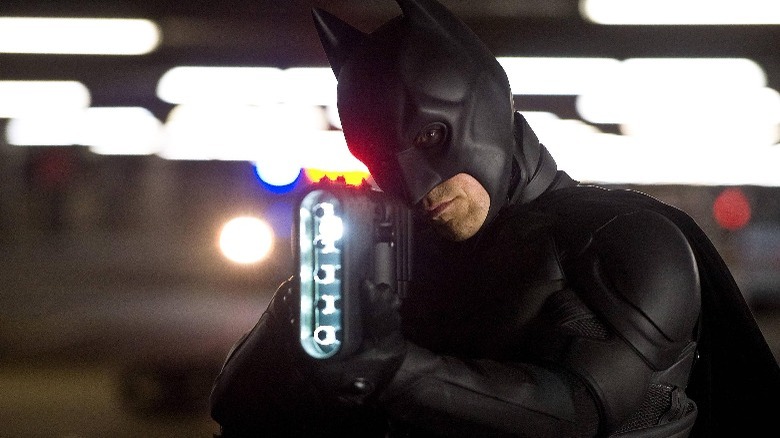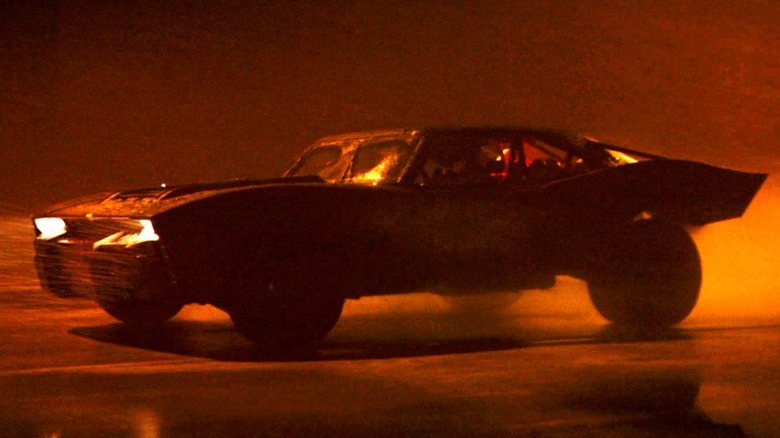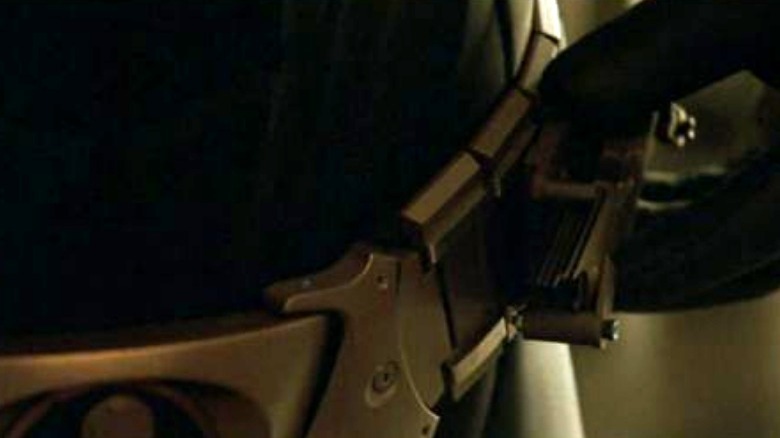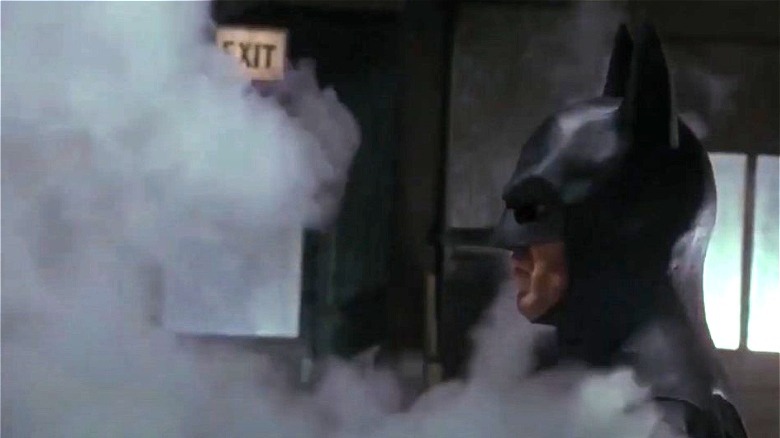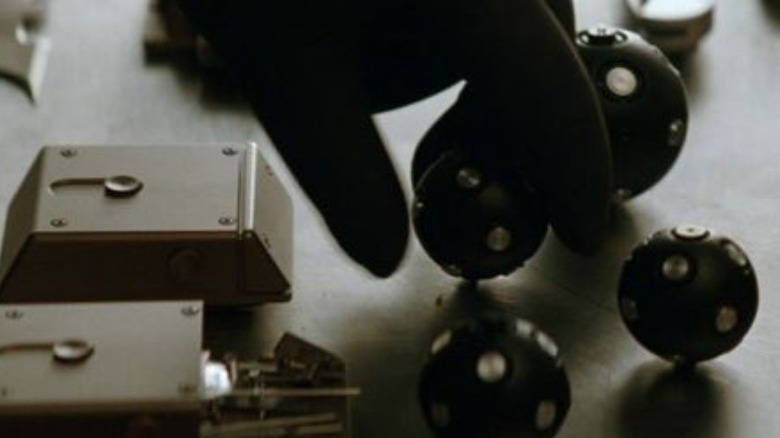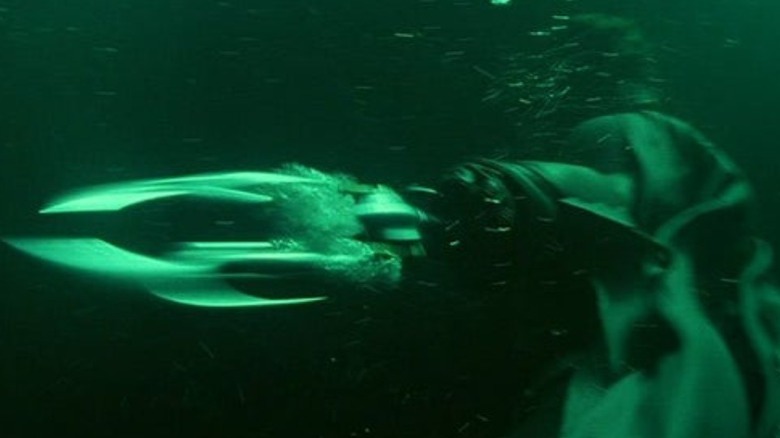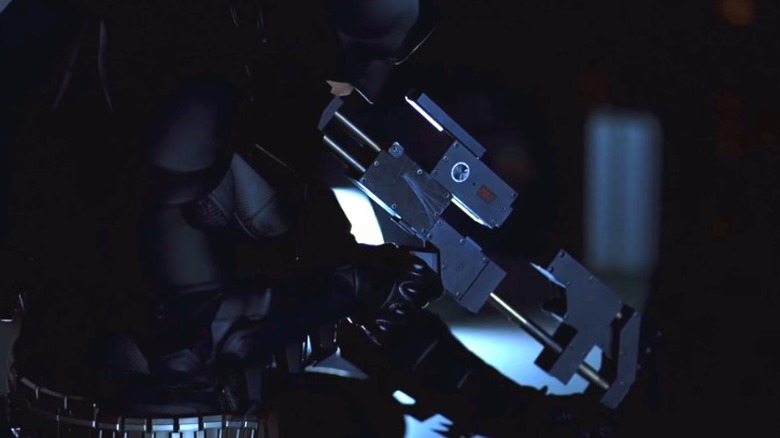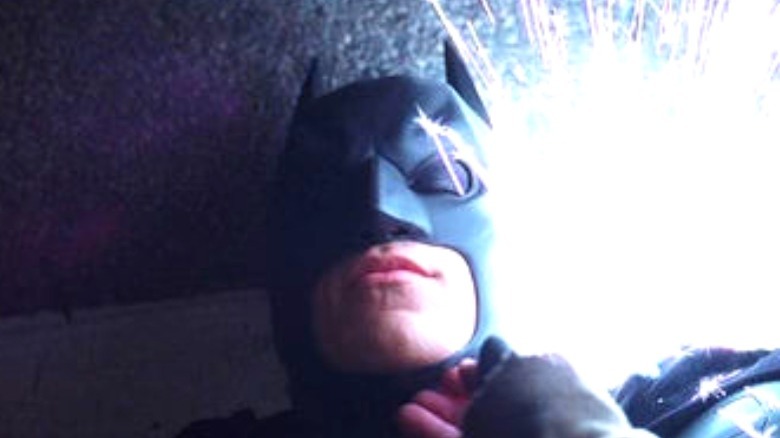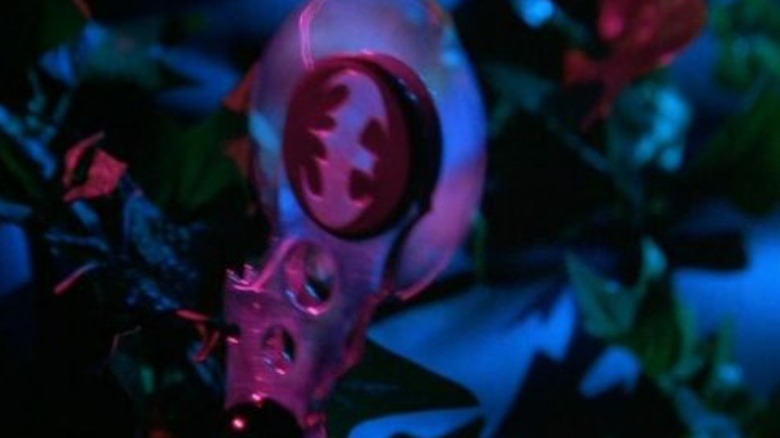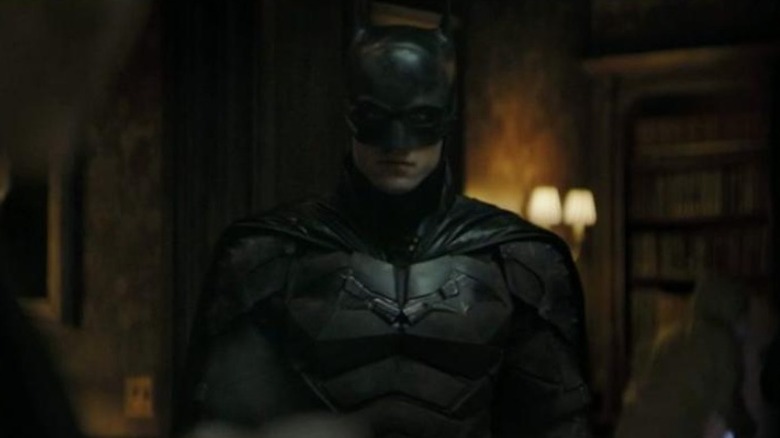The Best Batman Movie Gadgets We've Seen So Far
If you were a murderous thug in Gotham City, you might be familiar with the sensation of a batarang quickly whipping out of the dark and knocking you out cold as it collides with your skull. Batman might not kill, but he has no qualms with causing serious physical damage. Throughout his crusade against the criminal underbelly of Gotham, the Dark Knight employs a litany of gadgets to get the job done. Throughout the history of Batman in the colorful pages of DC comic books, the unique range of gadgets that make up his arsenal might even make James Bond's technological wizard of an associate, Q, blush.
Batman's live-action counterparts are no different. Ever since Adam West donned the cape and cowl in the 1960s series, Batman has often been seen using some of the wildest weaponry to combat the criminal element. Sometimes, the gadgets used were completely outrageous, like Batman's famous shark repellant. Most, however, enable Batman's strategic maneuvering like the sonar lens used in "The Dark Knight." Whatever the case may be, there's a wide variety of Bat-gadgets that the hero has turned to during his live-action adventures. Let's take a look at some of the best tools used by the Caped Crusader in film.
Grapple Gun
Perhaps, one of Batman's most famous tools of the trade, right next to the batarang, is his grapple gun. Just about every film iteration of the character has a grapple gun that enables the Caped Crusader to reach new heights rather quickly. Both Tim Burton's and Christopher Nolan's Batman are seen making consistent use of the grapple gun to stay out of the public eye. The Batman depicted in "Batman v Superman: Dawn of Justice" utilizes the tool to quickly evade deadly blasts from Doomsday. As a powerless human, gadgets like the grapple gun become essential in enabling Batman to move swiftly.
In "The Batman," he is seen sporting the most compact version of the tool yet as he quickly ascends a multi-story building indoors, passing by assailants on the staircase as they fire at him. There are other uses for the grapple gun beyond mere traversal. "Batman Begins" depicts a moment where Batman rigs a pulley system to entrap Detective Flass in an alley. He's hoisted up several stories before being suspended upside down where Christian Bale's Batman intensely interrogates the corrupt cop. In "The Dark Knight," Batman uses the grapple gun to catch the Joker as he falls off a building.
The grapple gun is an invaluable addition to Batman's arsenal, not only providing him an exfiltration strategy but also acting as a capable weapon in combat for subduing the opposition.
Batarang
No Batman movie is complete without batarangs in Batman's arsenal. Batarangs are often used to quickly stun an enemy. In some versions of the character, the batarang returns to Batman just like a boomerang. In other iterations, like Nolan's "The Dark Knight" trilogy, the batarang is more equivalent to a ninja star shaped like a bat. In "Batman Returns," some batarangs were infused with a bit of technology, and Batman can even be seen programming one batarang to target three separate individuals.
Both the Nolan version and Snyder version of the batarangs are often used to disable equipment from a distance. Christian Bale's Batman uses the weapons to take out light sources and even break windows, often adding a layer of tension for the criminals wondering what might be waiting for them in the dark. In the '60s Batman series and film, Batman would attach a rope to a batarang, which was often how he'd climb to higher locations.
Ultrasonic Signal (Bat summoner)
This nifty device was really only seen in "Batman Begins." Sometimes, Batman needs a solid distraction to make a smooth getaway or conceal his next move. In this film, Batman is seen removing a remote device from his shoe as he discusses the toxin Scarecrow used on Rachel with Jim Gordon. After a few moments, a flood of bats arrives on the scene bursting through windows and terrifying the police force huddled around the staircase. Gordon uses this opportunity to exit the building with an unconscious Rachel in tow. Meanwhile, Batman drops the signal down the stairwell so that the bats follow before he jumps in after it.
The ultrasonic signal is a brilliant piece of work that not only hypes up Batman's legend on the streets of Gotham but enables him to escape danger. Crazy stories of "the Batman" summoning bats at will would surely help his mystique and stoke fear in the newspapers. Perhaps, his enemies might wonder, he really is a creature of the night.
Rebreather
Scuba divers might be envious of this particular Batman tool. The rebreather has been featured in many comic book storylines and "Batman: The Animated Series." Often the device is employed when Batman has underwater work to attend to. It's seen in several different designs but ultimately acts as a filtration system. It extracts the oxygen from the water around Batman, enabling him to breathe underwater without the need for an oxygen supply. It's incredibly lightweight and, in many depictions, is a device Batman simply bites down on as he glides underwater.
Since this list is about gadgets in film, however, there is one instance where the rebreather appeared on the big screen. David Ayer's movie about Task Force X saw Batman outfitted with a facemask apparatus as he dove into Gotham harbor to retrieve Harley Quinn after a minor chase sequence at the beginning of the film. This is, of course, how Joker's beau ended up in prison and, subsequently, Task Force X. While the rebreather in the movie isn't the same design traditionally seen in the pages of the comics, it's a bit more practical as an airtight mask that seemingly performs the same task.
Gauntlets
Batman's gauntlets are often more about aesthetics than practicality. However, sometimes they are used to great effect as a defense mechanism from melee or projectile strikes. In Michael Keaton's iteration of the Dark Knight, Batman apparently puts his lightning-fast reflexes to use as he deflects incoming bullets with his gauntlets. It seems that Wonder Woman isn't the only one who can do this. However, she may be the only one capable of saving an entire crowd from automatic weapon fire -– Batman's not that fast.
Nolan's trilogy of films demonstrates a more practical use for the gauntlets. Of course, they're rooted in Bruce Wayne's combat training among the League of Shadows. In "Batman Begins," he is shown using them in his training to deflect blows from Ra's Al Ghul's sword. In "The Dark Knight," Lucius Fox gives them a bit of an upgrade, allowing the sturdier blades protruding from the gauntlet to be ejected at Batman's opponent. However, he uses this feature only at the tail-end of the film when he launches them at Joker after the mad man begins assaulting him.
Sonar Bat Vision
Come on, what's more bat-like than utilizing a gadget that allows Batman to harness the power of sonar? Batman lives in the shadows and it often seems like his own field of view might be skewed, either by darkness or that hefty cowl that sometimes doesn't support neck movement. Regardless, Batman usually has the odds stacked against him, and giving himself a bit of an edge seems appropriate. In "Batman Forever," the Dark Knight dons an entire sonar suit, complete with goggles, and it looks pretty slick. In fact, it seems to be more fashion over function. Maybe it just helped sell more toys.
"The Dark Knight" employs the best use of the sonar vision we've seen on the big screen to date. Lucius Fox finds a way to emit a signal from personal phones giving Batman a ma of the entire city wherever personal phones are being carried — so, basically everywhere. His cowl is outfitted with a lens that enables him to directly see the sonar mapping to help him take out the Joker and his goons while saving the hostages. Of course, Lucius ensures that Batman destroys the device once he's done using it because the invasion of personal rights and privacy is too great of a cost to allow the technology to continue operating.
EMP Gun
On the big screen, Batman typically contends with villains or thugs who are very human themselves. Without crazy powers, they must gather all manner of weaponry at their disposal to end the Dark Knight once and for all. Wouldn't it be great if Batman could disable most of their vehicles or weaponry with the flick of a switch or the squeeze of a trigger? An electromagnetic pulse capable of wiping out electronics wherever the device is activated is one such method. Batman, however, has figured out a way to focus an EMP and shut down specific machinery by simply pointing a gun and firing, so to speak.
In "The Dark Knight Rises," Batman is returning from an eight-year-long hiatus after his scuffle with the Joker over the heart and soul of Gotham City. A new and powerful mercenary named Bane is threatening stability within the city, and Bruce Wayne scrapes together what drive he has left to suit up and combat the forces of evil. After Bane and his mercenaries attack the stock exchange, Batman gives chase to his men on the back of his famous Batpod. He halts one thug's bike by pointing his EMP gun at it and disabling it. Unfortunately, that's the only use of the weapon we get to see in the film as a fresh-faced cop with a jumpy trigger finger then shoots the device.
Batmobile
What would Batman be without his trusty metal steed in the form of the roaring Batmobile? The Batmobile often goes hand-in-hand with Batman's crusade in Gotham City. The muscular machine is frequently depicted looking mean and ready for a fight. It's easily one of Batman's most intimidating pieces of hardware, often outfitted with an array of its own offensive and defensive functions much like a Swiss Army — car.
Some of the more complex Batmobiles to appear on screen, like Tim Burton's 1989 monster, can accomplish all types of feats, including doing a complete 180-degree turn in place, dropping bombs, firing discs, shielding the body of the car with indestructible armor, and cruising at high speeds with a jet engine.
Even Batman's earliest years, as depicted in "The Batman," showcase a more simplified Batmobile that is still highly capable, outfitted with a monster engine and nearly indestructible. The Penguin can pick any car he likes as there's no escaping that beast. The Batmobile is so iconic that it's practically its own character in the Batman mythos.
Utility Belt
Central to Batman's attire is none other than the utility belt. It's a staple of the character and has often been the source of countless gadgets and doo-dads capable of getting the Dark Knight out of a tight squeeze in his comic book history. Unfortunately, most of the major films haven't really explored the usage of this tool to a great extent, and it's often seen as more of an aesthetic choice or an accessory to the suit than an actual functioning gadget. The Joel Schumacher films clearly depict it as a glorified belt buckle in the montage scenes where Batman and Robin suit up.
The only films to give the utility belt the time of day are the more grounded-in-reality Nolan films. Batman isn't going to wear something for fashion's sake in these gritty movies. If it doesn't have a functional use, what's the point? In "The Dark Knight" trilogy, Batman has attachable compartments that often fit his belt. From there, he can pull out his batarangs, some of which are seemingly foldable. He likely used these compartments for other things, such as carrying the antidote to Crane's toxin in "Batman Begins," housing his blow darts in "The Dark Knight Rises," and even holding smoke pellets. Batman clearly doesn't have pockets, so the utility belt is an essential and functioning gadget.
Smoke Pellet
Speaking of smoke pellets, that's just one other tool the Dark Knight is equipped with in the event of an emergency. Batman's use of the shadows and his sources of training are often reminiscent of the art of ninjitsu. In Christopher Nolan's trilogy, that's an essential portion of the combat strategy employed by the League of Shadows. As such, Batman must become a master of his surroundings, only allowing his opponents to see him when he is ready to strike. The smoke pellet is crucial for making quick getaways, confusing the enemy, or causing a distraction.
In Tim Burton's 1989 "Batman," the smoke pellet is featured prominently in a pivotal scene in the first act of the film. Jack Napier and his gang are fending off a police raid at Axis Chemicals after the gangster attempts to destroy incriminating evidence. As the story goes, however, he falls into a vat of acid and is reborn as the Joker. The police then attempt to surround Batman, but he vanishes after dropping a smoke pellet.
Bat-bombs
Batman is always going to run into obstacles. Packing smaller explosives enables the hero to forge new paths, and they may even help destroy enemy hardware, making bat-bombs are another necessity in Batman's armory. Their most important requirement, however, is that they're small enough to handle and store while on the move.
Christian Bale's Batman has no issue with that. The bombs are small spheres that likely fit into one of the compartments he can attach to his utility belt. He is first seen using them in the third act of "Batman Begins" when he attempts to find a way out of the police station. He first summons his bats as a distraction and then heads down to the cellblock, where he uses the explosives to blast open a cell door and then blow a hole in the wall. While he avoids running into the police crowding the front of the building, there's no doubt that they hear the explosion. Like smoke pellets, these are often used only as a last resort.
Net Gun
Batman doesn't kill. At least, that's the rule of thumb. Many avid viewers of the films will likely disagree, considering his seeming penchant for negligent manslaughter (at best) in a handful of movies. Despite this conflict, the character needs non-lethal toys that help subdue enemies without inflicting the pain of death or turning them into a vegetable. A net gun seems like a fine tool that'd ultimately get the job done. After all, it keeps the criminals in one place and possibly even makes them easy for transport.
In film, Batman has only ever employed a net gun in one instance. Joel Schumacher's "Batman Forever" depicts Val Kilmer's Batman tussling with enemies underwater. To cease their hostilities, he fires a net gun underwater that captures the crew and — well, we're not sure what he does with them next. The film never reveals their fate, but let's hope he didn't use this non-lethal weapon to hold a bunch of poor saps underwater to drown while he ran off after the Riddler.
Sticky Bomb Gun
What's better than having bat-bombs at your disposal? Try sticky bombs that are fired from a gun. The only instance of this particular gadget is seen in "The Dark Knight" when Batman travels to Beijing to retrieve Mr. Lau, the mob's glorified accountant. Since the Chinese won't extradite a national, it's up to Batman to bring him back within Harvey Dent's jurisdiction to bring down the mob. Batman does so by firing sticky bombs set to a specific timer at the window panes of Mr. Lau's Beijing office building.
Batman swoops in and pummels Mr. Lau's security team, all while the clock is ticking down on those sticky bombs. As soon as Batman has cleared the room, he grabs Lau just in time for the police to arrive and corner the pair — or do they? The bombs detonate, leaving Batman an opening for exfiltration using a balloon-propelled hook and an airplane. It's quite an operation and probably one of the most satisfying operations that the Dark Knight has managed to pull off on screen, all thanks to his sticky bomb gun.
Electrified Cowl
Batman's secret identity as Bruce Wayne must be protected at all costs. If his cover were ever blown, it would destroy his means of operating as Batman. Bruce Wayne would likely be arrested or hounded by the public and would certainly be an active target for all of Batman's villains. Bruce Wayne's income funds his entire vigilante operation, meaning that Batman can't take any chances in regards to being exposed.
In "The Dark Knight," Batman takes extra measures to ensure that no one removes his cowl without his say-so. While the Joker and his crew attempt to bring down Harvey Dent's secure transport, Batman pursues the villain and does what he can to protect Harvey. Eventually, he puts the brakes on Joker's transport (literally) and Joker emerges from the wreckage. Although Batman seems to wish that he could run the Clown Prince of Crime over with his Batpod, he swerves out of the way at the last moment, avoiding giving into the temptation to break his no-kill rule.
As the Joker's goon approaches an unconscious Batman, he eagerly goes for the cowl in an effort to see the face of the man beneath the mask. However, the mask shocks the thug sending Joker into hysterics, preventing Batman's identity from being revealed. It's a useful gadget that many other superheroes could use.
Rotary Saw
Infiltrating compounds, breaking into secure vehicles, or cutting through bonds after being captured are all prospects Batman must consider. What tool might be useful in each of those situations? A rotary saw would do the trick, and there are actually two instances in the films where Batman makes use of exactly that. In "Batman and Robin," Batman uses a small rotary saw gadget to free himself from Poison Ivy's vines. Now all he needs is some weed killer, and he's got a winning combination for a duel with this particular villain.
In "The Dark Knight," Batman seemingly attempts to cut through the Scarecrow's fan as the villain attempts to flee. Unfortunately, he doesn't get far along in the cutting process before he's knocked off the side of the vehicle. It ends up not being a big deal matter, however, as a perfectly timed jump into the car garage got the job done.
Batsuit Armor
Even though Batman generally doesn't use traditional firearms in an effort to preserve life, his enemies don't share those sensibilities. As a result, Batman must do all that he can to prevent injuries from gunfire. While he sticks to the shadows, there will inevitably be a moment where he will be out in the open and in the sights of his enemies. Armor is essential for this very reason. The armor that Christian Bale's Batman wore wasn't entirely bulletproof. In fact, Lucius Fox designs the second version of the armor to be more versatile and allow Batman more mobility. Unfortunately, that lessened the amount of punishment the armor could take. While it might help protect him from melee blows, it doesn't stop him from taking a bullet from Two-Face.
The armor worn by Ben Affleck's Batman is a bit sturdier. In "Batman v Superman: Dawn of Justice," Batman takes a few gunshots to the head, but the cowl seems to keep his brains intact. He didn't even exhibit much in the way of shellshock from the impact. Blades are an entirely different story, however, as one enemy clearly plunges a dagger into his shoulder.
"The Batman" seems to have the most armored depiction of the batsuit yet. Robert Pattinson's version of the character has a thick chest plate that appears capable of withstanding the worst that any of the Riddler's or the Penguin's thugs might offer. Batman's defense must be as good as his offense.
